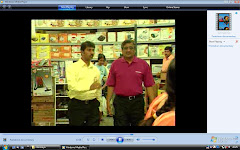Once one has got a clear understanding of the product mix it becomes very easy to plan the lay-out of the store and merchandise the goods. Various retailers use different types of layouts to merchandise their products depending on the size of the store, the type of products and location of the store.
Store layout:
Store layout should entertain customers to move around the store to purchase more merchandise than they may have originally planned. Before a store is set up the layout of the store is prepared. It involves the elevation plan for placing of fixtures on the walls and the floor; it shows how the walkway in a store should be and how much spacing needs to be given between departments and sections. Store layout is nothing but a Plano-gram of the store. It is similar like a map. It has information related to the sections, the fixtures used, area each section has occupied, which product is displayed where, and so on.
Grid layout: (Courtesy: Retailing Management-Levy and Weitz.)
It is mostly used in small grocery and FMCG store operations. It contains long gondolas of merchandise and aisles in a repetitive pattern. It isn’t the most aesthetically pleasing arrangement. Customers are not naturally drawn into the store.
Grid layout
ref: google site
o Racetrack track layout:
The race track layout facilitates the goal of getting customers to visit multiple departments.It is a type of store layout that provides a major aisle to facilitate customer traffic that has access to the store’s multiple entrances. This aisle “loops” through the store, providing access to smaller self contained departments.
The race track layout encourages impulse purchasing.
o Free-Form:
A free form layout arranges fixtures or aisles asymmetrically.Its successively used primarily in small speciality stores or within the departments of large stores.In this relaxed environment,customers feel like they are at someone’s home.Fixtures are likely to be expensive,hence customers are not naturally drawn towards the store.Hence personal selling becomes more important.Theft is higher in such layouts.
free flow layout
ref: google site
It is at Big Bazaar that I was exposed to most of the standard operating procedures, thanks to Ved Prakash Arya, the then CEO and his team. A proper SOP manual was in place in all the stores of Future Group to guide the store manager and his team to understand and follow the processes properly.
To understand the operations of a store one needs to be aware of all the day to day activities happening within a store. He needs to be a keen observer and should have a hunger for learning. One needs to ask questions to himself when inside a shop floor as to why the store lay out is in the way it is, why such a merchandise mix, understand and ask why fixtures are placed in a particular manner, and how it solves the problem, and which fixture is used when and where and why, and try to analyse each and every activity happening in the shop floor. The more you observe and the more you ask questions the more you come closer in understanding operations. You also need to understand the SOP for each and every process inside the store. Let’s understand this step by step. What is the first activity that happens when the store is ready to open?
what's missing in bangalore?
-
what do you miss the most when you move cities?
your friends? your colleagues? your favourite movie halls? eating joints?
your house/ flat/ apartment? the ...
15 years ago

No comments:
Post a Comment